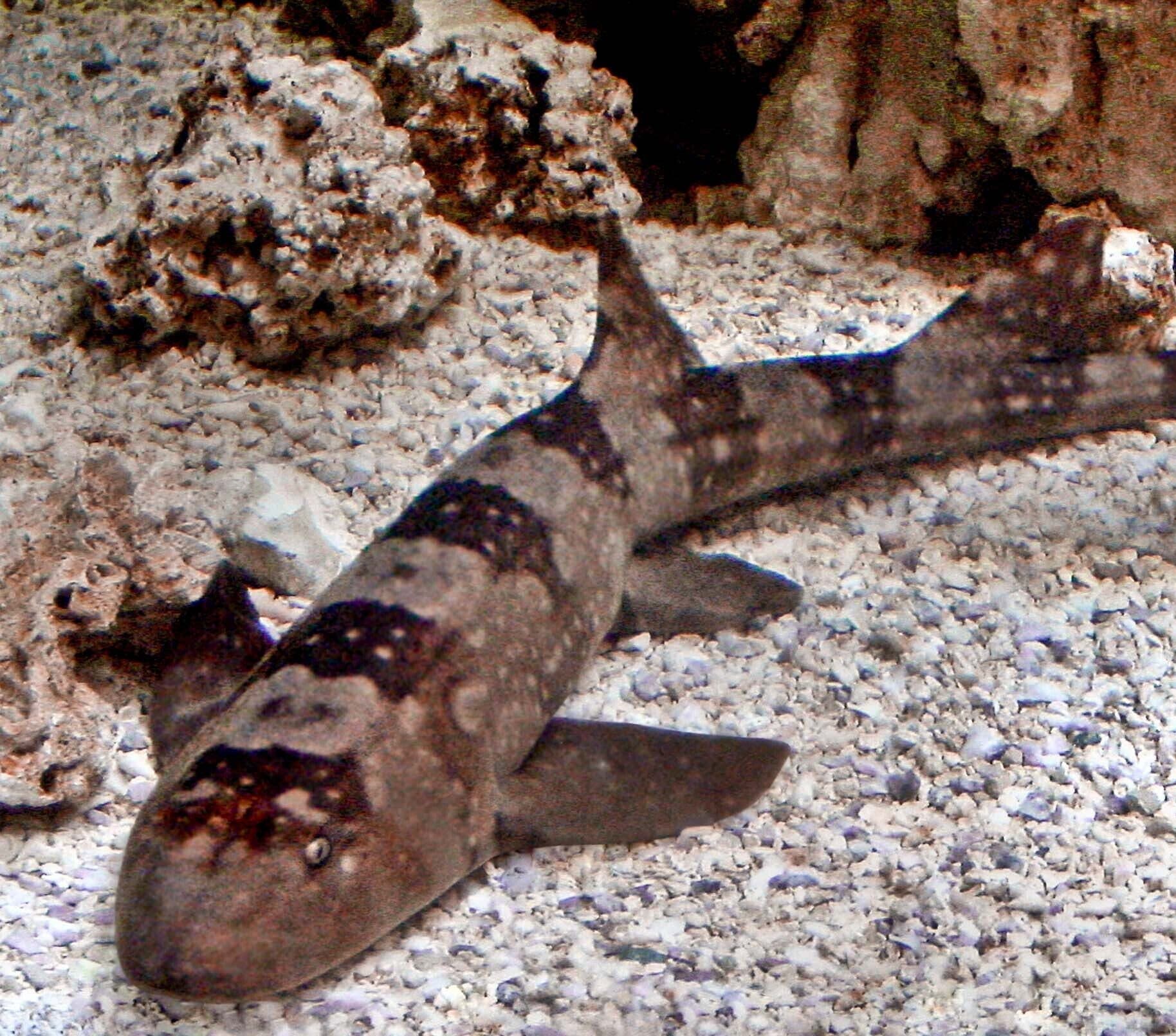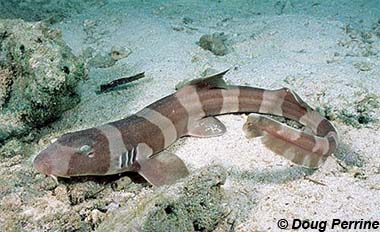Brownbanded Bamboo Sharks are small, nocturnal sharks found in the Indo-Pacific. They have distinctive brown bands on their bodies.
Brownbanded Bamboo Sharks, scientifically known as Chiloscyllium punctatum, are fascinating creatures native to the Indo-Pacific region. These sharks are relatively small, typically growing up to 41 inches in length. Their bodies feature striking brown bands, which help them blend into their surroundings.
They are nocturnal hunters, feeding primarily on small fish and invertebrates. Due to their manageable size and unique appearance, they are popular in home aquariums. These sharks are also known for their resilience and adaptability, making them an interesting subject of study for marine biologists. Understanding their behavior and habitat can aid in conservation efforts and ensure their survival in the wild.

Credit: stlzoo.org
Introduction To Brownbanded Bamboo Sharks
The Brownbanded Bamboo Shark is a fascinating marine creature. These sharks are known for their unique appearance and gentle nature. They are popular among aquarium enthusiasts.
Natural Habitat
Brownbanded Bamboo Sharks inhabit the Indo-Pacific region. They are commonly found in shallow waters. These sharks prefer sandy or muddy bottoms. You can often find them near coral reefs.
They are nocturnal and hide during the day. At night, they come out to hunt. Their diet mainly consists of small fish and invertebrates.
Physical Characteristics
The Brownbanded Bamboo Shark has a distinctive look. They have a slender body and can grow up to 41 inches long. Their coloration includes brown bands on a light background.
They have barbels near their mouth. These barbels help them sense prey. Their fins are rounded and not sharp.
| Feature | Description |
|---|---|
| Body Length | Up to 41 inches |
| Color | Brown bands on light background |
| Diet | Small fish and invertebrates |
| Behavior | Nocturnal |
Reproductive Habits
The Brownbanded Bamboo Shark has fascinating reproductive habits. Their mating rituals, egg laying, and incubation processes are unique and captivating.
Mating Rituals
Brownbanded Bamboo Sharks engage in interesting mating rituals. The male shark bites the female’s pectoral fin. This action is part of their courtship behavior. It helps the male to position himself correctly.
During mating, the male uses his claspers to transfer sperm. This ensures successful fertilization. The process is quick, usually taking only a few minutes.
Egg Laying And Incubation
After mating, the female lays eggs. Each female can lay up to 16 eggs at a time. The eggs are enclosed in tough, protective cases. These cases are often referred to as “mermaid’s purses”.
The eggs are left in safe places, often hidden among rocks or vegetation. This helps protect them from predators. Incubation lasts between 14 to 15 weeks. The temperature of the water affects the incubation period.
| Stage | Details |
|---|---|
| Mating Ritual | Male bites female’s pectoral fin |
| Sperm Transfer | Male uses claspers |
| Egg Laying | Up to 16 eggs in protective cases |
| Incubation | 14 to 15 weeks, water temperature dependent |
Once the eggs hatch, the baby sharks, or pups, are independent. They must fend for themselves from birth. This early independence is crucial for their survival.
Dietary Preferences
The Brownbanded Bamboo Shark is a fascinating creature with unique dietary habits. Understanding its dietary preferences helps in appreciating its role in the marine ecosystem. These sharks have adapted well to their environment, employing various techniques to hunt and capture prey.
Hunting Techniques
Brownbanded Bamboo Sharks are nocturnal hunters. They prefer hunting during the night. These sharks use their sensitive barbels to detect prey. Barbels are whisker-like organs near their mouths. They also rely on their keen sense of smell. This helps them locate food hidden in the sand or rocks.
They employ a method called “suction feeding.” The shark opens its mouth suddenly. This creates a vacuum that pulls in prey. Their small, sharp teeth then help to hold and consume the prey efficiently.
Common Prey
The diet of Brownbanded Bamboo Sharks includes a variety of marine life. They mostly eat small, slow-moving animals.
- Crustaceans: Crabs, shrimp, and lobsters are common prey.
- Mollusks: They consume snails, clams, and squid.
- Small Fish: They occasionally hunt small fish and juveniles.
- Worms: Polychaete worms are also a part of their diet.
These dietary preferences make Brownbanded Bamboo Sharks an essential part of the ocean’s food web. They help control the populations of their prey, maintaining ecological balance.
:strip_icc()/128117175-56a81f175f9b58b7d0f0dba7.jpg)
Credit: www.thesprucepets.com
Conservation Status
The Brownbanded Bamboo Sharks are fascinating creatures. Yet, their survival is at risk. Understanding their conservation status is crucial for their future.
Threats To Survival
Several factors threaten the survival of Brownbanded Bamboo Sharks:
- Habitat loss due to coastal development.
- Overfishing reduces their population.
- Pollution affects their health and habitat.
These threats reduce their chances of survival. Immediate action is needed to protect them.
Conservation Efforts
Efforts to conserve Brownbanded Bamboo Sharks include:
- Establishing marine protected areas.
- Enforcing fishing regulations to prevent overfishing.
- Conducting research to understand their needs.
These efforts aim to create a safer environment. Protecting their habitat is a priority.
| Conservation Effort | Goal |
|---|---|
| Marine Protected Areas | Protect shark habitats |
| Fishing Regulations | Reduce overfishing |
| Research | Understand shark needs |
Support these efforts to ensure the survival of Brownbanded Bamboo Sharks. Together, we can make a difference.
Interaction With Humans
Brownbanded Bamboo Sharks are fascinating creatures. They have unique interactions with humans. These interactions occur mostly in controlled environments. Let’s explore these interactions in more detail.
Aquarium Trade
The aquarium trade loves Brownbanded Bamboo Sharks. These sharks are popular in home and public aquariums. They are small and manageable compared to other shark species.
Key reasons for their popularity:
- Size: They grow up to 41 inches.
- Easy to care for: They adapt well to captivity.
- Appearance: Their brown bands are attractive.
These sharks need specific conditions. Their tanks should have hiding spots. The water should be warm and well-maintained. Proper care ensures they thrive in aquariums.
Human Encounters
Human encounters with Brownbanded Bamboo Sharks are usually safe. They are not aggressive by nature. Divers and snorkelers may see them in shallow waters.
Encounter tips:
- Do not touch or disturb them.
- Observe from a distance.
- Respect their habitat.
These sharks are more active at night. They rest during the day. Human encounters are rare during daylight hours.
Brownbanded Bamboo Sharks are interesting for marine biologists too. They study these sharks to understand their behavior. Such research helps in conservation efforts.
Research And Studies
The study of Brownbanded Bamboo Sharks is crucial for marine biology. These gentle creatures offer insights into marine ecosystems and species behavior. Researchers focus on various aspects of their life. This includes tagging and tracking and breeding programs.
Tagging And Tracking
Scientists use tagging to study shark movements. Tags help track their travel routes and habitat preferences. This data is essential for conservation efforts. Different types of tags are used, such as:
- Acoustic Tags
- Satellite Tags
- Radio Tags
Acoustic tags send sound waves to underwater receivers. These receivers collect data on shark locations. Satellite tags provide more detailed information. They can track sharks over long distances. Radio tags are less common but still useful. They help study sharks in shallow waters.
Breeding Programs
Breeding programs aim to increase shark populations. They help protect endangered species. These programs focus on controlled environments. Scientists study shark mating habits and egg development.
Breeding programs often involve:
- Creating safe habitats
- Monitoring water quality
- Ensuring proper nutrition
Table of Breeding Program Steps:
| Step | Description |
|---|---|
| 1 | Create safe habitats |
| 2 | Monitor water quality |
| 3 | Ensure proper nutrition |
Successful breeding programs can help save species. They offer hope for marine conservation.
Adaptations For Survival
The Brownbanded Bamboo Shark is a fascinating creature. It has unique adaptations for survival in its environment. These adaptations help it hide, find food, and stay safe from predators.
Camouflage
One key adaptation is camouflage. The Brownbanded Bamboo Shark has a brown and tan pattern. These colors blend with the sea floor. This helps the shark hide from predators and prey. It can stay still for long periods, making it hard to spot. Its body shape also helps it blend in with the surroundings.
Sensory Systems
The Brownbanded Bamboo Shark has excellent sensory systems. It uses electroreception to find prey. This means it can sense electric fields made by other animals. Its sense of smell is also very strong. It can detect tiny amounts of chemicals in the water. This helps the shark find food even in the dark or murky waters.

Credit: www.floridamuseum.ufl.edu
Cultural Significance
The Brownbanded Bamboo Shark holds a special place in various cultures. These sharks are not just fascinating creatures of the ocean. They also play a significant role in mythology and modern media. Let’s explore their cultural significance in more detail.
Mythology And Folklore
In many coastal regions, sharks are seen as symbols of strength. The Brownbanded Bamboo Shark is no exception. In some Asian cultures, these sharks are believed to bring good luck. Fishermen often tell stories of how these sharks guided them back home safely. There are also tales of these sharks protecting swimmers from danger.
In ancient folklore, these sharks were sometimes seen as guardians of the sea. People believed they had magical powers. Some stories even describe them as messengers between the human world and the ocean. These beliefs highlight the deep respect people have for these sharks.
Modern Media
The Brownbanded Bamboo Shark has made its way into modern media too. These sharks appear in documentaries and educational programs. They are often featured to teach kids about marine life. Their gentle nature makes them popular in family-friendly content.
In addition to educational programs, these sharks are also popular in aquariums. Many aquariums around the world showcase them. Visitors love to watch them swim gracefully. This exposure helps to raise awareness about their conservation.
Movies and TV shows sometimes feature Brownbanded Bamboo Sharks. They are often depicted as mysterious yet friendly creatures. This portrayal helps to change the perception of sharks as dangerous animals.
Here’s a quick summary of their cultural significance:
| Aspect | Details |
|---|---|
| Mythology | Symbols of strength and good luck, guardians of the sea |
| Modern Media | Featured in documentaries, aquariums, and family-friendly content |
Conclusion
Brownbanded Bamboo Sharks are fascinating creatures worth learning about. They make unique pets for dedicated aquarists. By understanding their care requirements, you can ensure they thrive in captivity. These sharks contribute to marine biodiversity and spark interest in ocean conservation.
Remember, responsible pet ownership is key to their well-being.
